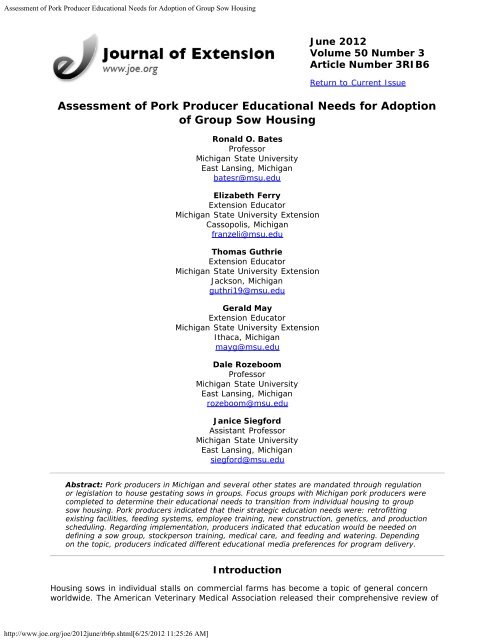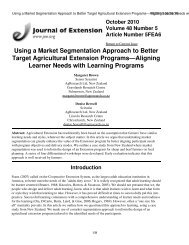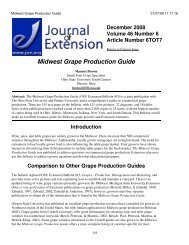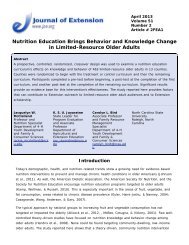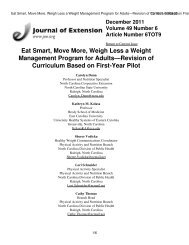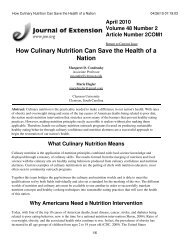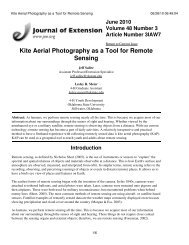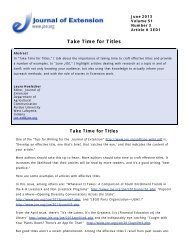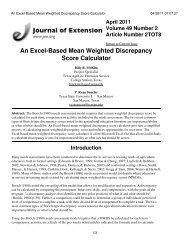Assessment of Pork Producer Educational Needs for Adoption of ...
Assessment of Pork Producer Educational Needs for Adoption of ...
Assessment of Pork Producer Educational Needs for Adoption of ...
You also want an ePaper? Increase the reach of your titles
YUMPU automatically turns print PDFs into web optimized ePapers that Google loves.
<strong>Assessment</strong> <strong>of</strong> <strong>Pork</strong> <strong>Producer</strong> <strong>Educational</strong> <strong>Needs</strong> <strong>for</strong> <strong>Adoption</strong> <strong>of</strong> Group Sow Housing<br />
June 2012<br />
Volume 50 Number 3<br />
Article Number 3RIB6<br />
Return to Current Issue<br />
<strong>Assessment</strong> <strong>of</strong> <strong>Pork</strong> <strong>Producer</strong> <strong>Educational</strong> <strong>Needs</strong> <strong>for</strong> <strong>Adoption</strong><br />
<strong>of</strong> Group Sow Housing<br />
Ronald O. Bates<br />
Pr<strong>of</strong>essor<br />
Michigan State University<br />
East Lansing, Michigan<br />
batesr@msu.edu<br />
Elizabeth Ferry<br />
Extension Educator<br />
Michigan State University Extension<br />
Cassopolis, Michigan<br />
franzeli@msu.edu<br />
Thomas Guthrie<br />
Extension Educator<br />
Michigan State University Extension<br />
Jackson, Michigan<br />
guthri19@msu.edu<br />
Gerald May<br />
Extension Educator<br />
Michigan State University Extension<br />
Ithaca, Michigan<br />
mayg@msu.edu<br />
Dale Rozeboom<br />
Pr<strong>of</strong>essor<br />
Michigan State University<br />
East Lansing, Michigan<br />
rozeboom@msu.edu<br />
Janice Sieg<strong>for</strong>d<br />
Assistant Pr<strong>of</strong>essor<br />
Michigan State University<br />
East Lansing, Michigan<br />
sieg<strong>for</strong>d@msu.edu<br />
Abstract: <strong>Pork</strong> producers in Michigan and several other states are mandated through regulation<br />
or legislation to house gestating sows in groups. Focus groups with Michigan pork producers were<br />
completed to determine their educational needs to transition from individual housing to group<br />
sow housing. <strong>Pork</strong> producers indicated that their strategic education needs were: retr<strong>of</strong>itting<br />
existing facilities, feeding systems, employee training, new construction, genetics, and production<br />
scheduling. Regarding implementation, producers indicated that education would be needed on<br />
defining a sow group, stockperson training, medical care, and feeding and watering. Depending<br />
on the topic, producers indicated different educational media preferences <strong>for</strong> program delivery.<br />
Introduction<br />
Housing sows in individual stalls on commercial farms has become a topic <strong>of</strong> general concern<br />
worldwide. The American Veterinary Medical Association released their comprehensive review <strong>of</strong><br />
http://www.joe.org/joe/2012june/rb6p.shtml[6/25/2012 11:25:26 AM]
<strong>Assessment</strong> <strong>of</strong> <strong>Pork</strong> <strong>Producer</strong> <strong>Educational</strong> <strong>Needs</strong> <strong>for</strong> <strong>Adoption</strong> <strong>of</strong> Group Sow Housing<br />
research that compared the per<strong>for</strong>mance and welfare <strong>of</strong> sows housed individually in stalls or in<br />
groups and found neither method had documentable differences <strong>for</strong> animal welfare (Sow<br />
Housing Task Force, 2005). Yet the use <strong>of</strong> individual stalls to house sows has continued to come<br />
under increasing scrutiny from consumers (Tonsor, Wolf, & Olynk, 2009). The European Union<br />
(EU) has disallowed the use <strong>of</strong> individual stalls <strong>for</strong> sows after 4 weeks <strong>of</strong> pregnancy (Council<br />
Directive 2001/88/EC), and all member states must be in compliance by January 1, 2013. In the<br />
United States, several states (Florida, Arizona, Cali<strong>for</strong>nia) have passed ballot initiatives to ban<br />
housing sows in individual stalls <strong>for</strong> defined portions <strong>of</strong> gestation, while other states (Oregon,<br />
Colorado, Maine) have passed negotiated legislation that accomplished a similar outcome.<br />
In the fall <strong>of</strong> 2009, Michigan also passed legislation (Public Act 117) that amended the Animal<br />
Industries Act (Michigan Public Act 488 <strong>of</strong> 1988) to disallow housing gestating sows in individual<br />
stalls. Within the legislation, sows that have been confirmed pregnant must be able to turn<br />
around freely, lie down, stand up, and fully extend their limbs. Sows can be housed in stalls <strong>for</strong><br />
up to 7 days be<strong>for</strong>e their expected farrowing date, through farrowing and lactation, and after<br />
weaning until they are confirmed pregnant. Housing gestating sows in stalls is allowable <strong>for</strong><br />
veterinary examination, testing, or treatment as directed by a veterinarian. This legislation<br />
became effective March 31, 2010, and producers must comply with the legislation by April 1,<br />
2020.<br />
Though it may seem that Michigan pork producers have an extended period <strong>of</strong> time to decide<br />
how best to comply with this legislative mandate, the 10-year compliance horizon will pass<br />
quickly. For example, among the 13 EU nations that must comply with the EU regulation on sow<br />
housing, the percentage <strong>of</strong> sows in group housing within a country ranged from 20 to 70%<br />
when there were 30 months remaining to meet the compliance mandate by the 2013 target<br />
(Martin, 2010). The purpose <strong>of</strong> the study reported here was to develop an understanding <strong>of</strong> the<br />
educational needs among Michigan pork producers and begin to create the educational resources<br />
pork producers will need to transition into group housing <strong>of</strong> sows.<br />
Methods<br />
Focus groups were completed in February and March 2010 at three locations in Michigan.<br />
Guidelines used to <strong>for</strong>m each focus group were developed as suggested by Gamon (1992). Each<br />
location was chosen to be close to sow farms, but the geographical area would not overlap with<br />
one <strong>of</strong> the other locations chosen. <strong>Pork</strong> producers near the location <strong>of</strong> each focus group were<br />
invited to attend through a written invitation followed by telephone call from a Michigan State<br />
University Extension (MSUE) <strong>Pork</strong> Team member. The Michigan <strong>Pork</strong> <strong>Producer</strong>s Association pork<br />
producer database was used to generate mailing lists <strong>for</strong> the written invitations. <strong>Producer</strong>s were<br />
asked to register in advance, but no registration fees were collected. In addition, producers<br />
were asked that, if possible, one management person and one animal technician represent their<br />
farm at the focus group. Across the three focus groups, 27 males and three females attended.<br />
At each focus group, a general introduction <strong>of</strong> the topic was given, which was then followed by<br />
three interactive sessions. One MSUE <strong>Pork</strong> Team member took notes, while another acted as the<br />
moderator <strong>for</strong> each session and was familiar with participants in attendance. This was done to<br />
increase familiarity and to improve communication among participants.<br />
In Session I, participants were asked to finish the following statement, "When my farm changes<br />
to group housing <strong>for</strong> gestating sows I will need more in<strong>for</strong>mation/education about…" with topics<br />
that would finish this statement from a Strategic or Whole-Farm point <strong>of</strong> view. This tactic was<br />
used to approach the issue <strong>of</strong> what in<strong>for</strong>mation would be needed <strong>for</strong> a farm to change their<br />
infrastructure to adopt group sow housing. Participants were provided an initial listing <strong>of</strong> topics<br />
(Figure 1) to consider. Participants could keep, modify, delete, or add to the list <strong>of</strong> items that<br />
would complete the statement.<br />
Figure 1.<br />
Initial Ideas <strong>for</strong> Consideration by Michigan <strong>Pork</strong> <strong>Producer</strong>s <strong>for</strong> the Question,<br />
"When my farm changes to group housing <strong>for</strong> gestating sows I will need<br />
more in<strong>for</strong>mation/education about…" When Considering a Strategic or Whole-<br />
Farm Point <strong>of</strong> View<br />
http://www.joe.org/joe/2012june/rb6p.shtml[6/25/2012 11:25:26 AM]
<strong>Assessment</strong> <strong>of</strong> <strong>Pork</strong> <strong>Producer</strong> <strong>Educational</strong> <strong>Needs</strong> <strong>for</strong> <strong>Adoption</strong> <strong>of</strong> Group Sow Housing<br />
1. Characterization <strong>of</strong> Different Group Housing Options<br />
2. Retr<strong>of</strong>it Options – Characterization and Concerns<br />
3. Retr<strong>of</strong>it Cost Comparisons<br />
4. New Construction Options/Costs<br />
5. Employee Training – Managing Gestating Sows in Groups<br />
For Session II, participants were asked to consider the same statement as discussed in Session<br />
I. However, participants were asked to consider this statement from a tactical or day-to-day<br />
implementation point <strong>of</strong> view. As in Session I, participants could keep, modify, delete or add to<br />
the initial list <strong>of</strong> items (Figure 2) that would complete the statement.<br />
Figure 2.<br />
Initial Ideas <strong>for</strong> Consideration by Michigan <strong>Pork</strong> <strong>Producer</strong>s <strong>for</strong> the Question,<br />
"When my farm changes to group housing <strong>for</strong> gestating sows I will need<br />
more in<strong>for</strong>mation/education about…" When Considering a Tactical or<br />
Implementation Point <strong>of</strong> View<br />
1. Sow Behavior in Groups<br />
2. Consequences <strong>of</strong> Mixing Sows<br />
3. Sow Handling<br />
4. Feeding Practices <strong>for</strong> Sows in Groups<br />
5. Medical Care and Observation <strong>of</strong> Sows in Groups<br />
6. Pen and Facility Requirements <strong>for</strong> Group Housed Sows<br />
For Sessions I and II, moderators did not influence the responses provided by the participants<br />
and encouraged them to create new or alternative topics not initially provided. Once the lists <strong>of</strong><br />
items were completed within each session, participants were asked to designate which items<br />
were <strong>of</strong> most importance to them. This was done by placing an adhesive dot by the item <strong>of</strong><br />
their choice. Participants were given five dots that they could use as they chose to. After the<br />
completion <strong>of</strong> each session, MSUE <strong>Pork</strong> Team members tallied the number <strong>of</strong> responses to each<br />
<strong>of</strong> the topics listed and reported back to the participants the listing <strong>of</strong> topics and the number <strong>of</strong><br />
responses <strong>for</strong> each, including only those topics that received at least one vote.<br />
Session III focused on potential educational delivery tools. Participants were asked to consider<br />
the type <strong>of</strong> educational media that would be preferable <strong>for</strong> each <strong>of</strong> the reported topics in<br />
Sessions I and II. Participants were provided a list <strong>of</strong> possible educational delivery tools (Figure<br />
3), and they were asked if they wanted to modify, delete, or add to the list <strong>of</strong> items. Once the<br />
list was completed, each participant was given three adhesive dots <strong>for</strong> each topic and asked to<br />
use the adhesive dots to designate three tools <strong>for</strong> each <strong>of</strong> the topics that would be a preferable<br />
means <strong>for</strong> educational delivery <strong>of</strong> this topic.<br />
Figure 3.<br />
Initial Delivery Tools Considered by Michigan <strong>Pork</strong> <strong>Producer</strong>s <strong>for</strong> Delivery <strong>of</strong><br />
Group Sow Housing <strong>Educational</strong> Programs<br />
1. Face to face workshop – common location<br />
2. Face to face workshop – on farm<br />
3. One on one – on farm<br />
4. Internet based workshops, seminars, webinars<br />
5. Teleconference with pre-mailed PowerPoint slides<br />
6. Pr<strong>of</strong>essional pre-recorded CDs/DVDs<br />
7. Hardcopy (printed) media (bulletins, factsheets, etc) available to<br />
order<br />
8. Internet bulletin board with downloads <strong>of</strong> – factsheets and bulletins<br />
http://www.joe.org/joe/2012june/rb6p.shtml[6/25/2012 11:25:26 AM]
<strong>Assessment</strong> <strong>of</strong> <strong>Pork</strong> <strong>Producer</strong> <strong>Educational</strong> <strong>Needs</strong> <strong>for</strong> <strong>Adoption</strong> <strong>of</strong> Group Sow Housing<br />
9. Internet bulletin board with downloads <strong>of</strong> – spreadsheet calculators<br />
10. Internet bulletin board with downloads <strong>of</strong> – videos <strong>of</strong> management<br />
practices (e.g., YouTube type video)<br />
Results and Discussion<br />
Participants in each focus group were not given any results from any other focus groups. After<br />
completion <strong>of</strong> all three focus groups, results were aggregated across focus groups. Topics had to<br />
be ranked at more than one <strong>of</strong> the focus group sessions to be included. Figure 4 lists those<br />
educational topics that producers indicated were <strong>of</strong> highest priority <strong>for</strong> improving their strategic<br />
planning. Subcategories <strong>for</strong> each priority were those provided by participants to further describe<br />
their needs within each category. <strong>Producer</strong>s indicated that their highest priority was <strong>for</strong><br />
in<strong>for</strong>mation regarding what options were available to retr<strong>of</strong>it existing facilities and what feeding<br />
systems to consider. Yet there were strong opinions regarding need <strong>for</strong> further in<strong>for</strong>mation on all<br />
<strong>of</strong> the ranked topics.<br />
Figure 4.<br />
Strategic Planning In<strong>for</strong>mation <strong>Needs</strong> by Michigan <strong>Pork</strong> <strong>Producer</strong>s <strong>for</strong> Group<br />
Sow Housing a<br />
Rank<br />
Topic<br />
1 Retr<strong>of</strong>it Options<br />
a. Characterization & Comparisons<br />
b. Cost Comparisons<br />
c. Characterization <strong>of</strong> Different Group Housing Options<br />
d. New Technology<br />
2 Feeding Systems<br />
a. Methods<br />
b. Equipment/Technology<br />
c. Cost Comparisons<br />
3 Employee Training<br />
a. Managing Sows in Groups<br />
b. Managing Body Condition Score<br />
c. Minimizing Aggression<br />
d. Handling Pregnant Sows<br />
e. Assessing Employee Skill Level & Adaptability<br />
4 New Construction<br />
a. Cost Comparisons & Option<br />
b. Regulations<br />
c. Comparison between Retr<strong>of</strong>it Options and New Construction<br />
5 Genetics<br />
a. Durability<br />
b. Productivity<br />
c. Temperament<br />
d. Breeds/Lines by Group/Pen Size<br />
6 Production Scheduling<br />
http://www.joe.org/joe/2012june/rb6p.shtml[6/25/2012 11:25:26 AM]
<strong>Assessment</strong> <strong>of</strong> <strong>Pork</strong> <strong>Producer</strong> <strong>Educational</strong> <strong>Needs</strong> <strong>for</strong> <strong>Adoption</strong> <strong>of</strong> Group Sow Housing<br />
a. Sow Flow by Stage <strong>of</strong> Gestation<br />
b. Phase Segregation – by Stage <strong>of</strong> Gestation<br />
a Rankings were determined through aggregation <strong>of</strong> results across focus<br />
groups.<br />
In Figure 5, the highest ranked topics pertaining to in<strong>for</strong>mational needs <strong>for</strong><br />
tactical/implementation planning are listed. Defining sow groups and how to <strong>for</strong>m them ranked<br />
highest, while Employee training ranked second. For both strategic and tactical planning,<br />
Employee/Stockperson training and education were areas <strong>of</strong> concern. This suggests that pork<br />
producers were concerned about the effect <strong>of</strong> this change on their employees. Successful<br />
implementation <strong>of</strong> group sow housing will require that employees understand how group housing<br />
can be implemented to maintain historical productivity and appreciate that their daily routine<br />
and skills will change to successfully implement group sow housing.<br />
Figure 5.<br />
Tactical/Implementation In<strong>for</strong>mational <strong>Needs</strong> by Michigan <strong>Producer</strong>s <strong>for</strong><br />
Group Sow Housing a<br />
Rank<br />
Topic<br />
1 Defining a Sow Group<br />
a. Large Pen vs. Small Pen<br />
b. Group Size, Pen Configuration, Square Footage/Sow, Sow Size<br />
(Body Condition Score & Weight)<br />
c. Forming New Sow Groups – Mixing and Sorting<br />
2 Stockperson Training<br />
a. Sow Behavior & Observation<br />
b. Stockperson Adaptability to Change<br />
c. Learning New Technologies and Equipment Maintenance<br />
d. Finding Non-Pregnant or Open Sows<br />
e. Sow Handling<br />
3 Medical Care<br />
a. Sow <strong>Assessment</strong> and & Medical Treatment in Groups<br />
b. Vaccinations<br />
4 Feeding & Watering Technologies in Groups<br />
a. Feed Form – Bulkiness etc<br />
b. Calibration – Allotment per Sow<br />
c. Water Delivery<br />
a Rankings were determined through aggregation <strong>of</strong> results across focus<br />
groups.<br />
Table 1 provides producer preferences <strong>for</strong> different educational delivery methods <strong>for</strong> each topic<br />
related to strategic decision-making. At each <strong>of</strong> the focus groups, participants included using<br />
email as a means <strong>for</strong> in<strong>for</strong>mation transfer. <strong>Producer</strong> preferences <strong>for</strong> different educational<br />
delivery methods were somewhat dispersed across the different strategic topics, but some<br />
interesting patterns emerged. <strong>Producer</strong>s showed preference <strong>for</strong> Internet-based methods and<br />
consistently wanted on-demand access to in<strong>for</strong>mation that could be accessed from an Internet<br />
http://www.joe.org/joe/2012june/rb6p.shtml[6/25/2012 11:25:26 AM]
<strong>Assessment</strong> <strong>of</strong> <strong>Pork</strong> <strong>Producer</strong> <strong>Educational</strong> <strong>Needs</strong> <strong>for</strong> <strong>Adoption</strong> <strong>of</strong> Group Sow Housing<br />
bulletin board containing in<strong>for</strong>mation and tools. This is consistent with recent reports that<br />
farmers use a wide array <strong>of</strong> technology in both their business and private life (Guenthner &<br />
Swan, 2011).<br />
Yet producers continued to want some educational <strong>of</strong>ferings through more traditional methods<br />
(Face to face – common location, Face to face – on-farm, One on one – on-farm). This was<br />
particularly true <strong>for</strong> Employee Training, with 37% indicating a preference <strong>for</strong> these traditional<br />
methods <strong>of</strong> educational program delivery. In addition, participants indicated that the use <strong>of</strong><br />
distance educational methods (Internet-Based Workshops, Teleconference with PowerPoint TM<br />
slides, Pre-recorded CDs/DVDs) was an acceptable method <strong>for</strong> in<strong>for</strong>mational delivery and<br />
technology transfer. This suggests that pork producers are adapting to advanced methods <strong>of</strong><br />
communication and will utilize a variety <strong>of</strong> communication media to acquire the in<strong>for</strong>mation they<br />
need <strong>for</strong> decision-making.<br />
Table 1.<br />
Preferences (Response %) <strong>of</strong> <strong>Educational</strong> Methods by Strategic In<strong>for</strong>mational Topic <strong>for</strong><br />
Michigan <strong>Pork</strong> <strong>Producer</strong>s<br />
Retr<strong>of</strong>it<br />
Options<br />
Feeding<br />
Systems<br />
Employee<br />
Training<br />
New<br />
Construction<br />
Genetics<br />
Production<br />
Scheduling<br />
Face to Face<br />
Common<br />
Location<br />
Face to Face<br />
On-Farm<br />
One on One<br />
On-Farm<br />
Internet Based<br />
Workshop<br />
Teleconference<br />
with<br />
PowerPoint<br />
Pre-Recorded<br />
12 15 17 9 8 13<br />
5 7 11 0 0 4<br />
8 9 9 11 8 4<br />
13 12 11 13 13 11<br />
5 6 4 6 4 6<br />
10 11 12 6 4 6<br />
CDs/DVDs<br />
Hardcopy<br />
Media<br />
Internet<br />
Bulletin Board<br />
Downloads <strong>of</strong><br />
Factsheets<br />
Internet<br />
Bulletin Board<br />
Downloads <strong>of</strong><br />
Spreadsheet<br />
Calculators<br />
Internet<br />
Bulletin Board<br />
Downloads <strong>of</strong><br />
Videos<br />
13 9 13 11 11 11<br />
12 13 5 21 25 21<br />
9 8 2 11 6 6<br />
3 4 9 4 4 11<br />
Email Listserv 10 6 7 8 17 7<br />
http://www.joe.org/joe/2012june/rb6p.shtml[6/25/2012 11:25:26 AM]
<strong>Assessment</strong> <strong>of</strong> <strong>Pork</strong> <strong>Producer</strong> <strong>Educational</strong> <strong>Needs</strong> <strong>for</strong> <strong>Adoption</strong> <strong>of</strong> Group Sow Housing<br />
Table 2 contains participant preferences <strong>for</strong> different educational delivery methods <strong>for</strong> ranked<br />
topics pertaining to tactical/implementation planning. For the topics <strong>of</strong>, Defining a Sow Group<br />
and Stockperson Training, producers indicated they would prefer traditional educational methods<br />
(Face to face common location, Face to face, on-farm, One on one on-farm) over that <strong>of</strong> an<br />
Internet bulletin board <strong>of</strong> resources and tools. This is similar to the finding that farmers<br />
preferred more traditional methods <strong>of</strong> learning methods (Franz, Piercy, Donaldson, Westbrook, &<br />
Robert, 2010). However, <strong>for</strong> the topics <strong>of</strong> Medical Care and Feeding and Watering, distance<br />
education methods (Internet based workshops, Teleconference with PowerPoint slides, Prerecorded<br />
CDs/DVDs) and an Internet bulletin board with on-demand in<strong>for</strong>mation and tools along<br />
with traditional educational methods were all ranked similarly. This indicates that pork producers<br />
do value different educational options differently depending on the topic and how the<br />
in<strong>for</strong>mation may be used.<br />
Table 2.<br />
Preferences (Response %) <strong>of</strong> <strong>Educational</strong> Methods by Tactical In<strong>for</strong>mational<br />
Topic by Michigan <strong>Pork</strong> <strong>Producer</strong>s<br />
Defining a<br />
Sow<br />
Group<br />
Stockperson<br />
Training<br />
Medical<br />
Care<br />
Feeding<br />
and<br />
Watering<br />
Face to Face Common<br />
Location<br />
14 16 13 13<br />
Face to Face On-Farm 8 11 7 4<br />
One on One On-Farm 8 14 3 8<br />
Internet based Workshop 8 8 10 11<br />
Teleconference with<br />
PowerPoint slides<br />
10 8 7 5<br />
Pre-recorded CDs/DVDs 6 11 7 6<br />
Printed Hardcopy 10 10 18 13<br />
Internet Bulletin Board<br />
with Factsheet Downloads<br />
Internet Bulletin Board<br />
with Spreadsheet<br />
Calculators<br />
Internet Bulletin Board <strong>of</strong><br />
Videos<br />
16 9 16 16<br />
7 2 2 11<br />
7 7 9 4<br />
Email Listserv 6 4 8 10<br />
These focus groups provided critical insight into the educational needs <strong>of</strong> pork producers as they<br />
consider their options <strong>for</strong> changing a key phase <strong>of</strong> their production system. In addition, other<br />
livestock industries may consider how the results obtained in the study reported here may be<br />
applicable to their circumstances. The results from these focus groups will be used to develop an<br />
educational curriculum to address the needs pork producers will have as they transition from<br />
individual to group sow housing. Furthermore, pork producers indicated their preferred methods<br />
<strong>of</strong> delivery <strong>of</strong> educational programs regarding both strategic and tactical implementation<br />
planning. These preferences will be used to develop educational delivery methods that meet the<br />
need <strong>of</strong> Michigan pork producers as they implement management practices to meet future<br />
legislated requirements <strong>for</strong> group sow housing in gestation.<br />
Acknowledgments<br />
This work was funded in part by a Michigan State University Extension Program Reinvestment<br />
http://www.joe.org/joe/2012june/rb6p.shtml[6/25/2012 11:25:26 AM]
<strong>Assessment</strong> <strong>of</strong> <strong>Pork</strong> <strong>Producer</strong> <strong>Educational</strong> <strong>Needs</strong> <strong>for</strong> <strong>Adoption</strong> <strong>of</strong> Group Sow Housing<br />
Fund grant. The authors wish to thank the Michigan <strong>Pork</strong> <strong>Producer</strong>s Association <strong>for</strong> their help<br />
and assistance with this project.<br />
References<br />
Council Directive 2001/88/EC amending Council Directive 91/630/EEC. Retrieved from:<br />
http://eurlex.europa.eu/LexUriServ/LexUriServ.do?uri=CELEX:32001L0088:EN:HTML<br />
Franz, N. K., Piercy, F., Donaldson, J., Westbrook, J., & Robert, R. (2010). Farmer, agent, and<br />
specialist perspectives on preferences <strong>for</strong> learning among today's farmers. Journal <strong>of</strong> Extension<br />
[On-line], 48(3) Article 3RIB1. Available at: http://www.joe.org/joe/2010june/rb1.php<br />
Gamon, J. A. (1992). Focus groups: A needs assessment tool. Journal <strong>of</strong> Extension [On-line],<br />
30(1) Article 1TOT2. Available at: http://www.joe.org/joe/1992spring/tt2.php<br />
Guenthner, J. F., & Swan, B. G. (2011). Extension learners' use <strong>of</strong> electronic technology. Journal<br />
<strong>of</strong> Extension [On-line], 49(1) Article 1FEA2. Available at:<br />
http://www.joe.org/joe/2011february/a2.php<br />
Martin, M.A . (2010). Report from the 2010 meeting <strong>of</strong> Interpig. Teagasc Pig E-Newsletter.<br />
Retrieved from: http://www.teagasc.ie/pigs/newsletters/2010/PigNewsletterJuly2010.pdf<br />
Sow Housing Task Force. (2005). A comprehensive review <strong>of</strong> housing <strong>for</strong> pregnant sows. Journal<br />
<strong>of</strong> the American Veterinary Medical Association. 227:1580-1590.<br />
Tonsor, G. T., Wolf, C., & Olynk, N. (2009). Consumer voting and demand behavior regarding<br />
swine gestation crates. Food Policy, 39, 492-498.<br />
Copyright © by Extension Journal, Inc. ISSN 1077-5315. Articles appearing in the Journal<br />
become the property <strong>of</strong> the Journal. Single copies <strong>of</strong> articles may be reproduced in electronic or<br />
print <strong>for</strong>m <strong>for</strong> use in educational or training activities. Inclusion <strong>of</strong> articles in other publications,<br />
electronic sources, or systematic large-scale distribution may be done only with prior electronic<br />
or written permission <strong>of</strong> the Journal Editorial Office, joe-ed@joe.org.<br />
If you have difficulties viewing or printing this page, please contact JOE Technical Support.<br />
http://www.joe.org/joe/2012june/rb6p.shtml[6/25/2012 11:25:26 AM]


